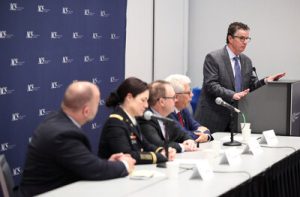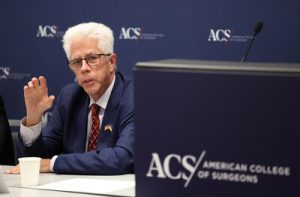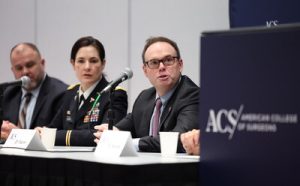CHICAGO — Seconds matter and can mean the difference between life and death with any injury or medical emergency that causes severe loss of blood.
Surgeons at the forefront of trauma and critical care surgery discussed at a recent news conference the urgent need to make quick access to blood — one of the most critical elements in determining a patient’s survival — more widely available to injured patients before they arrive at a hospital.
At the American College of Surgeons Clinical Congress in San Francisco, panelists emphasized the impact faster access to blood could have on reducing preventable deaths — potentially saving 10,000 lives each year — from traumatic injuries and other bleeding emergencies.

“We have an opportunity to save thousands of lives a year with a single intervention, prehospital blood. Uniform access of blood can have a major impact on outcomes for our trauma patients,” said the panel moderator, Dr. Jeffrey Kerby, chair of the ACS Committee on Trauma and director of the Division of Trauma and Acute Care Surgery at the University of Alabama at Birmingham Heersink School of Medicine. Prehospital blood refers to blood administered before a patient arrives at a hospital.
Bleeding to death is a leading cause of preventable death for people of all ages that can be greatly reduced with quicker access to trauma care, Kerby said.
Whenever there is a dramatic loss of blood, the bleeding not only needs to be controlled but blood also needs to be supplied to patients early on to prevent them from going into hemorrhagic shock. Someone can bleed to death within minutes. When blood is given to severely bleeding patients as soon as possible, their chances of survival increase dramatically.
Unfortunately, very few Emergency Medical Services agencies carry blood, said Dr. John B. Holcomb, professor of the Division of Trauma & Acute Care Surgery at UAB Heersink School of Medicine. Most often, EMS vehicles carry crystalloid (saline), which costs less than blood but is much less effective and potentially even harmful to some patients who suffer from hemorrhagic shock.

“There’s no need to do more studies, the data are very clear: pre-hospital blood absolutely saves lives,” Holcomb said.
Despite compelling data on its life-saving potential, only about 1 to 2% of EMS agencies carry blood, he said, and an even smaller fraction of patients in need of blood receive it from EMS agencies.
These “blood deserts” have long-lasting impacts. Holcomb estimated that about 10,000 lives could be saved per year if every U.S. ambulance carried blood.
“There are not many things we can do as a community that are already FDA-cleared and are already proven that will save 10,000 lives in the U.S.,” he said.
Barriers to Care
While the promise of prehospital blood is immense, several barriers prevent its wider adoption.
Dr. Peter E. Fischer, an associate professor of surgery at the University of Tennessee Health Science Center, noted two primary barriers preventing widespread access to pre-hospital blood: local regulations, which vary by state, and lack of adequate reimbursement.
In some states, EMS professionals are not allowed to provide blood to patients before they arrive at the hospital due to state regulations; additionally, reimbursement for EMS agencies, which often operate on a volunteer or fee-for-service model, is usually based on transportation only, not necessarily the care provided.
Fischer estimated that about 175 EMS ground crews in the U.S. carry blood, but most of these crews do so at their own cost. While recent Centers for Medicare & Medicaid Services changes recognizing the importance of blood in the pre-hospital setting are a step in the right direction, they don’t go far enough to ensure widespread reimbursement coverage to EMS agencies, he said.
“We need to fix the scope of practice issues that we see throughout the United States … and switch the paradigm such that EMS agencies can get reimbursed for this life-saving issue,” Fischer said.
The situation is even more dire for the estimated 30 to 40 million Americans who live more than an hour away from a major trauma center, said Dr. Michael Person, associate professor of surgery at the University of South Dakota Sanford School of Medicine.
“Only about 1% of EMS agencies carry blood. In rural areas, that’s down to almost zero,” he said. “The only way to get prehospital blood is possibly an air flight, which is challenging if you live in a rural community that doesn’t always work that way.”
Person emphasized that disparities in rural areas make this population especially vulnerable to preventable bleeding deaths. While only about 19% of Americans live in a rural area, a disproportionate number of motor vehicle crashes — about half — occur in a rural setting, he said.
Transfer time to the hospital is more than double or triple for patients living in rural areas, leaving many injured patients without access to timely care.
“We have to move [access to] blood to where the people are,” Person said. “The problem is where the people are, it’s not at the hospital. We really need to push that forward to get [blood] to where it’s needed and that’s in the field, which is very challenging logistically because of the disparity of being in a rural setting.”
Lessons from the Military
For blood to become more widely available in the pre-hospital setting, logistical and administrative challenges within hospital systems will also need to be addressed.

Army Col. Jennifer Gurney, MD, chief of the Department of Defense Joint Trauma System, described lessons learned from military trauma care, which provides whole blood transfusion to injured service members who require urgent attention in the field. Whole blood refers to blood that has not been separated into its component parts, such as plasma or platelets, and may be more beneficial for trauma patients in need of quick access to blood.
The wars in Iraq and Afghanistan further highlighted the need for quick access to blood in the field and its lifesaving potential. Gurney cited military research showing that administering whole blood within 36 minutes after injury quadrupled a person’s chances of surviving and decreased 30-day mortality three-fold. That study and other data from the wars showed the immense life-saving promise of using whole blood in the field.
“Our conventional and special operations forces do not go out on missions down range without blood,” Gurney said. “It’s a check box, they must have blood.”
While maintaining a pre-hospital whole blood program outside of the military system will require close coordination between blood banks and local hospital trauma systems, many of these challenges are surmountable with collaboration and information-sharing.
Gurney highlighted a military-civilian partnership with the Southwest Texas Regional Advisory Council which enables first responders in the San Antonio area to provide patients in hemorrhagic shock with whole blood before they arrive at a hospital.
“The transfusion practices are one of the best examples of the reciprocity between military and civilian trauma systems and how we can learn from each other,” she said.
Call to Action
Change rarely occurs overnight. For blood to become more widely available to patients before they arrive at a hospital, the panelists described critical steps to move forward:
- Donate blood: The nation is facing a critical shortage of blood supply. More blood is needed for quick access to blood to become a reality.
- Advocate for change: Ask if your local EMS system carries blood. If they don’t, contact your local elected officials to advocate for change, the panelists said.
- Share success stories: Stories have the power to move people and help them understand policy issues. Share stories of the people whose lives were saved by having quick access to blood.
“Patients get injured in the field; let’s start care in the field and take down some of the barriers that we have so that we can provide this life-saving resource at the point of injury and start it as early as possible,” Fischer said.
Don’t miss out! Subscribe to our email newsletter to have all our smart stories delivered to your inbox.


